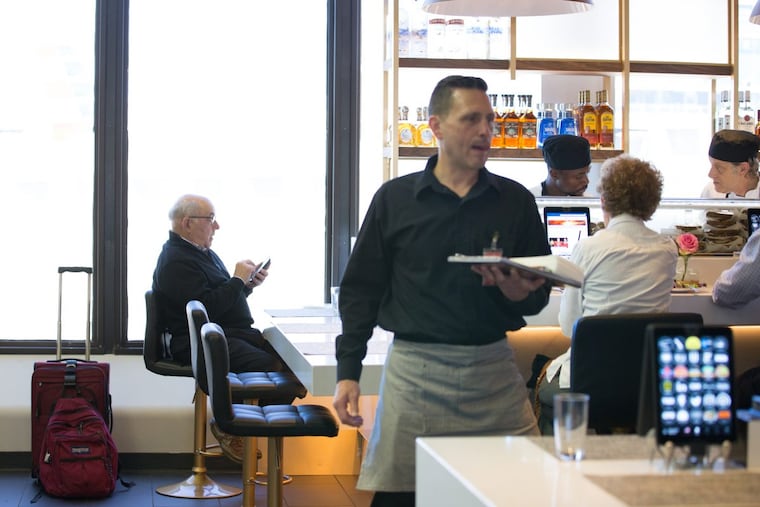Airlines at PHL agree to $900 million in improvements
Led by hub carrier American, the airlines have approved the capital improvements at the Philadelphia airport.

Want a French pastry, German beer, or Neapolitan pizza? At the touch of an Apple iPad, you can order those and more at three new restaurants in the gate areas of Terminal B at Philadelphia International Airport.
The $32.8 million terminal redesign, which will bring 1,100 iPads and eight new restaurants and retail offerings inside the security perimeter, is part of a $900 million investment at PHL recently approved by airlines in their lease agreement with the city.
Three of the restaurants – a French pastry cafe, a German beer garden, and an Italian restaurant – opened this month. The remaining restaurants and iPads will get up and running over the next year.
"In my 15 years at the airport, this is the largest investment that the airlines have made at one time," said Rhett Workman, a managing director at American Airlines, which operates 390 daily flights and a hub in Philadelphia.
After the December 2013 merger of US Airways and American, Philadelphia's hub carrier, which transports 73 percent of passengers here, paused to focus on integrating the airlines into the world's largest passenger carrier.
Three years later, American said, it's time to focus on its long-term strategic vision for Philadelphia. The airlines, led by American, have committed $395.9 million for infrastructure improvements — replacing roofs, elevators, escalators, HVAC units, and security and technology upgrades.
The most visible change will come in several years when American builds a "head house," a new front entrance at PHL to replace the Terminal B and C ticketing areas, with automated baggage handling and a centralized, spacious, passenger-security checkpoint that has been talked about for a decade.
In 2007, airlines approved $40 million for the B-C Terminal design, and in 2013 authorized $200 million to begin construction. It didn't happen. Now, that money will be used to design a new B-C arrivals building to be located between Terminal A-East and Terminal B, on what is currently mostly open space.
The airlines have authorized $96.5 million to remove and relocate a concessions warehouse and loading dock in that area to make way for a new central entrance for all American flights, and an automated checked-bag screening system with explosives-detection equipment and a conveyor system that goes from the ticket counter to the planes.
The project will be completed in five to seven years, Workman said. The current baggage system in Terminals B and C has a life span of only six to eight more years, he said.
"We are looking at what is our 10- to 20-year investment here," said Suzanne Boda, senior vice president, who until recently was in charge of American's nine hubs. "Philadelphia is part of our very long-term plan for the airline. It's a very, very important hub for us, and we need to make these investments in order to sustain ourselves and have a great place for all of us to work and for our customers to have a great experience here."
Airlines — not city taxpayers — will foot the bill for most of the improvements through their rates and charges and debt service on bonds. The iPads and eateries in Terminal B will be bankrolled by New York-based food and beverage provider OTG Management.
Passengers also help pay for airport capital projects through a $4.50 "passenger facility" fee assessed to every ticket. The user fee generates about $61 million annually for PHL.
Still in the works is a multistory, consolidated rental-car building to replace current rental-car surface lots. Initial cost estimates to build where the car companies are currently were high, so the airport looked at sites nearby. However, the car companies said they want to stay where they are, and will present design and construction plans in coming months, said Philadelphia airport CEO Chellie Cameron.
An automated "people mover" to transport passengers between terminals is on hold. In the interim, American has rerouted connector buses to reduce the transit time between terminals to five to seven minutes and has purchased 12 new buses. "For the time being, we have a very reliable and consistent connector bus service that works," Workman said. "The people-mover system is being looked at, but as a longer-term investment as we start to expand the terminal complex."
"We have to make Philadelphia an affordable and convenient airport," Workman said. "We can't simply say we want to build everything we want at the airport — it's $20 billion, and then we have to pay the debt service and try to pass it on to our customers. You know what happens if you raise fares $50 or $100 here? Newark becomes more attractive. Baltimore becomes more attractive. Our customers have other options."
Building for the Future
Here's a breakdown of what the airlines support:
Build a $197.5 million FAA air traffic control tower to replace the 1983 tower on Hog Island Road.
Spend $94.6 million to modernize fuel pumping and storage at a 1970s facility to increase the airport fuel supply to five to 10 days from the current three to four day supply.
Invest $43.2 million in aircraft deicing equipment.
Acquire land parcels for $27.1 million around PHL for future development.
Purchase airfield snow removal equipment and an aircraft rescue and firefighting vehicle for $6.2 million.